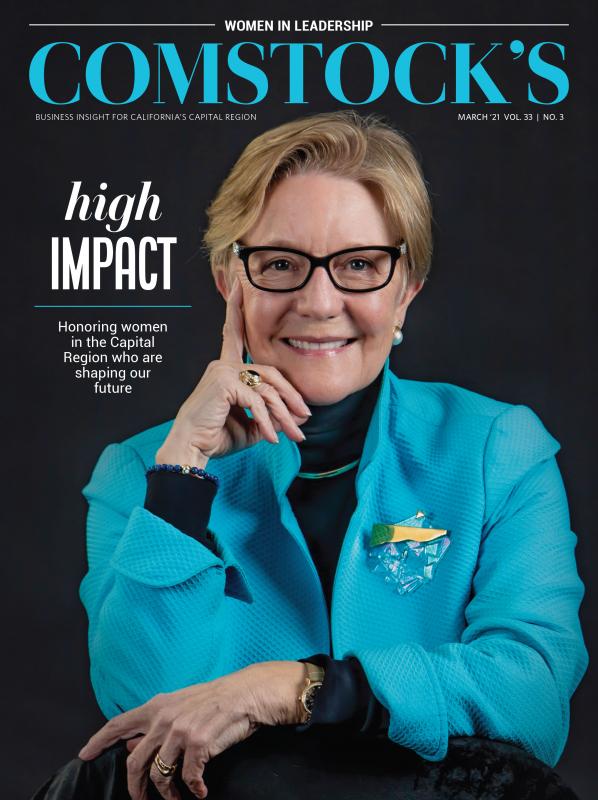Cate Dyer founded StemExpress in 2010 and is CEO of the Folsom-based biotechnology company, which procures biospecimens for research and development, clinical trials, and commercial use. The company collects both healthy and diseased samples from human bone marrow, umbilical cord blood, stem cells, biopsy tumors and other sources, which it then supplies to researchers and clinicians working to develop tests, new drugs, diagnostic devices and more to treat and cure diseases.
StemExpress has a network of health care partnerships with hospitals and systems in both the United States and Europe. The company also has seven cellular clinics in the U.S. to collect blood, cells and tissue from patients and donors. The Sacramento Metropolitan Chamber of Commerce named Dyer its 2021 Businesswoman of the Year. Comstock’s spoke to Dyer about her company’s function as an accelerator of medical advancement.
How did you get into this line of work, and why is this work important to you?
I was premed through school. I actually started working in Santa Barbara Cottage Hospital in the emergency room, and thought I would be an emergency room physician. I started working … with the transplant teams that would come in to do organ collection for transplantation. I realized, at the time, that the majority of us have pink dots on our (driver’s) license that say we want to be a donor. (It’s) about 80 percent of Californians.
But the sad fact is that by the time someone gets to a place in their life where they are passing away, usually there’s enough restrictive issues that less than 2 percent of people actually qualify. The reason could be that they recently had cancer, or the reason they’re passing away is something that’s a disease-based situation, and so that stops the collection of healthy tissues used for transplantation.
What dawned on me is it’s just a gigantic missing link in this — the majority of what takes people’s life is disease, and the issues with not being able to collect transplant material because of disease (creates) this big black hole where nothing is really being collected then that supports disease research. … When I was working in the emergency room, I knew, for example, breast cancer researchers that were waiting for breast biopsy samples from rare forms of cancer, but if somebody passed away from a rare form of cancer, there was no method to collect those biopsy samples to send those to research institutes that were studying those diseases.
When I first started dreaming up how to solve that problem (I) was thinking … how could we focus on disease-based tissues or blood samples, etc., in a way that helped speed up the time it would take for disease researchers to do their work and ultimately get better cures, drugs, devices to market faster. When we first started the company, right away, we started with a handful of companies that, for example, were going to collect a specific type of blood from disease patients, and they knew how hard it was to get those samples. It was going to take them six years to collect enough samples to show their work to the (Food and Drug Administration) to get approved for their blood tests. We were able to work with that company and get it down to under three years by just mass collecting in a space across multiple spectrums, hospitals, clinics and so on to actually speed that time frame up.
StemExpress is a big accelerator. When I think about R&D work, when I think about clinical trials, the companies and the entities doing this work, that’s one of the biggest hurdles they have. If you’re creating a device and you want to get it approved by the FDA, and that device is meant to work on all general population of patients, the FDA is going to have you do thousands (of), if not 60,000, different test cases — different ethnicities, different genders, different ages — to show that machine is relevant and works correctly across that whole spectrum. If you’re creating a machine just for cancer patients, they’re going to have to limit that scope to a smaller number of samples, but you still have to show it on all different forms of cancer, different criteria, different gender and ages.
What really slows down the success of things coming to market is this collection period. For us, as patients out in the world, when we’re expecting that cutting-edge technology to come, the fact that it takes so long to deliver those things, to get to good requirements, to ultimately produce a good product was where I saw the biggest frustration and felt like StemExpress could play a crucial role to help speed up those time frames and ultimately allow these companies to get to market faster with their cures, drugs, devices, etc.
You started the company with $9,000. Do you now have outside investors? If not, why has it been important to keep the company independent?
We have no outside investors; it’s all grown organically within the company. … We purposely kept really outside investors out. With most outside investment companies, they usually have a 2-3-year turnaround until they’re out, and the next group is in, be it an IPO, be it another round of seed money or private equity. Most of those groups want to sell to the highest bidders. … In our world, that would be pharmaceutical companies. If we’re supporting five major pharmaceutical companies to get their successful product (to market) as fast as possible, there’s an easy interest that one of those pharma companies could want to buy us so we can’t support the others. We’ve seen this from day one.
It’s almost six years from the time something is FDA approved to be in every hospital across the United States accessible to patients. Terrible. That means if we had the cure for cancer today, that’s how long it would take.
I have lots of pharma companies interested in acquiring StemExpress because they see us as the engine to help bring things to market. … Our mission is to support patients. It’s not to support stockholders in these companies. Our mission is to get products to market faster and support the treatments that patients so desperately need. So it’s crucially important for us to stay … independent and to support all five companies working on a specific type of cancer to all be successful or for all five to be as successful as possible faster, because that’s what helps patients. That’s what gets (patients) the best options available.
Several months ago, StemExpress partnered with Sacramento County to ramp up COVID-19 testing efforts. Can you tell me about that undertaking and how it’s been going?
We created 10 different testing sites that people could go to on behalf of the county. … Our staff would physically man these sites and have some personnel from the county as well. We created a scheduling tool. … If people could schedule and we knew there were 500 people coming in, we could be prepared for 500 tests. … They didn’t have to wait in line for hours, and we could filter them through and then use that to ultimately dictate what was needed on the site. We can also dictate that back to our lab — our lab was physically running the tests. … So when we got those samples, then we could turn around the testing in roughly 24 hours, which was another huge issue we saw across this pandemic was huge wait times and issues with turnaround time.
Besides COVID-19 testing, what are some of the other big projects or focus areas underway for your company?
Vaccines. During this pandemic, we’ve been trying to take that model that I just explained that works really well and say, “How can we now also add vaccines?” … So (we’re) not only managing the testing phase but also the vaccine. We are making progress and have been on calls with senior officials at the White House, Health and Human Services, and Indian Health Service … about how to take the model that we’ve really built successfully here and apply it … more on a national scale and include vaccine deployment as well. The progress since Jan. 20 has been slower than I, or the community I know, was hoping for. This administration came into a much worse situation than was public, but they are starting to round the corner and getting great leaders in place.
Does StemExpress have other initiatives in the works?
A key part of our core business as a company is really that speed in which patients can actually receive the treatment they so desperately need. … A big passion for me has been to always see (our efforts) come full circle, if you think about it, from the onset of R&D to clinical trials through commercialization. (We’re) redefining the word commercialization. For us, our focus has been that redefinition. For example, in previous years, our success, we would look at it from the standpoint of an FDA-approved product. We help a client get all the way through to an FDA-approved product. But then what I noticed is it would take years sometimes to get that (product) out to every hospital. It’s terrifying if you really look at the numbers. It’s almost six years from the time something is FDA approved to be in every hospital across the United States accessible to patients. Terrible. That means if we had the cure for cancer today, that’s how long it would take.
We started realizing that we could partner with hospitals and become the bolt-on solution for cellular and gene therapies. For example, when company A develops a cellular or gene-based treatment, the patients’ cells need to be collected by a company that handles cells on a regular basis. If a hospital wants to offer these cutting-edge treatments, they could send their patients to a StemExpress facility in which the patient would have cells collected for their upcoming cell-therapy treatment. These therapies currently include cancer (CAR-T), tissue engineering, as well as tendon and ortho repairs. Once the cells have been collected and extracted, they can be routed directly back to the health care provider or sent to the manufacturer for further manipulation. StemExpress fills the gap needed to accelerate these offerings on a local basis, but (also) on a global scale.
This has been a big initiative we are really focused on. We’ve been talking to a lot of the big regional hospitals about executing this to bring this forward. But, again, it ties back to that core mission: How can we speed up the process? When we see a slowdown in the pipeline that’s affecting the execution of good quality care to patients, that’s where we dig in. This next phase for us is really that partnership with health care (systems) to deliver better patient treatment.
In the November 2020 election, California voters passed Proposition 14, which approved $5.5 billion for stem cell and other medical research and keeps the California Institute for Regenerative Medicine open. What’s your perspective on Prop. 14, which builds upon Proposition 71, passed in 2004, to support stem cell research in the state?
It has pros and cons. … In general, the initial language of the proposition and the funding associated with it was really clear. It talked about job creation in California. It talked about cutting-edge therapies and treatments for patients in California. And it talked about the money and royalties staying within California. So if entities developed something, they would use California companies, ideally, to ultimately produce products for Californians. I think there has not been enough good oversight and guidelines when it comes to how Californians believed these funds would be spent.
There’s been money that’s been spent outside … California. There’s been money spent on projects that are not essentially going to make it to a commercial level of production for patients. And then there’s the question of the rights of the development of the product or the treatment and the ownership of those rights. … If Californians pay to fund work that produces a treatment, Californians should own the rights as well. … If entity A owns those rights and then charges Californians a fortune for what they’ve created, we sort of missed the whole picture. There needs to be better accountability.
In 2015, you were involved in congressional hearings around your work with Planned Parenthood. Can you tell me what lessons you learned from that experience?
The lesson I learned (is) when there are political hot buttons that come up in our country, people dig in oftentimes and not with all of the facts. Sometimes (they) can purposely mislead the facts to fulfill their own agenda, which is what happened with us in 2015. The work we did with Planned Parenthood has always been predominantly to support women having healthy pregnancies. For example, the work we did with them in Fresno, in an area where Planned Parenthood is one of the only (places) to treat uninsured patients that are pregnant with prenatal drugs and prenatal care to help them have healthier pregnancies. One of the things we did was to collect a lot of maternal blood down in Fresno to support lifesaving treatments through blood therapy and with companies to develop better testing for women when they’re pregnant. So much of that got overshadowed by a handful of bad actors that wanted to focus on creating their own messaging about those relationships.
There will always be people — no matter whether or not you’re curing cancer or saving lives or creating new technology — that will disagree with the methods used to ultimately produce a good outcome. I’ll give you a current-day example. … The New York Times did a great article recently about (an antibody) treatment that Donald Trump had, by Regeneron, when he had COVID. That treatment had fetal cells in it. … Trump talked about how it was a treatment that he thinks saved his life during COVID. There’s always components of things where people push back, and people will disapprove of the methods or research being done, but I think at the end of the day, if all the researchers do their job well and stay within the ethical guidelines and follow the (National Institutes of Health) and all the (regulations), great things can be created that actually save lives.
What advice do you have for other women entrepreneurs?
In mentoring and coaching other women entrepreneurs, (I advise them) to not shy away from engagement groups that are very male-dominated. Sometimes we have spent so long as women feeling like we’re maybe the only woman in the room with male colleagues (that) some of us have been driven to women-only groups, which are fabulous as well. I participate there heavily too. But I think it’s also really crucial to not silo ourselves. … I participate in Vistage, the CEO group, and it is heavily male. … It’s important for women leaders to lean into that, to ultimately not shy away from those challenges or those events, and to learn from our male colleagues and to educate them if we see … women being sidelined or (men) not asking their participation in conversation; to bring that up and bring that forward in a way that’s not threatening but engaging.
Edited for length and clarity.
–
Get all the stories in our annual salute to women in leadership delivered to your inbox: Subscribe to the Comstock’s newsletter today.
Recommended For You

Breaking Ground
Women in the Capital Region are founding biotech companies with a global reach — but venture capital remains elusive
Women founders in the Capital Region are developing groundbreaking technology in biotech and ag-tech, emerging industries where territory is still uncharted.

Women in Leadership: Dr. Diana Farmer
Our annual salute to extraordinary women who are shaping our future
Dr. Diana Farmer, chair of the department of surgery at UC Davis Health, is the world’s first woman fetal surgeon.

Cracking the Glass
Local leaders weigh in on the state of gender equality in the workplace
Focusing on four sectors — STEM, justice, development and investment — we rounded up some of the city’s key leaders: a district attorney, a med school dean, the head of an FBI office and enough CEOs to rival “Shark Tank,” to get their take on how women are perceived in their industries, how that perception has changed over time and what it will take to truly reach parity.

Agriculture and Beyond
The Next Chapter: Pam Marrone, pioneer of biological agricultural products, expands her reach through advising
Pam Marrone, who retired as CEO of Marrone Bio Innovations in
2020, didn’t take a break; she still works 10-12 hour days.




